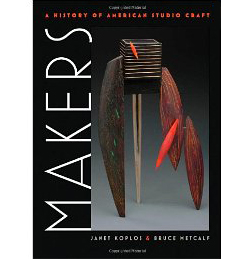Interpreting Ceramics | issue 13 | 2011 Articles & Reviews |
|
|||||||
|
Book Review by Martina Margetts Makers: a history of American studio craftAuthor: Janet Koplos and Bruce Metcalf |
|
|||||||
|
This is a 529-page tome from 1876 to 1999, with over a 1000 footnotes (but no bibliography) and is part of a multi-platform educational project by the Center for Craft, Creativity and Design (CCCD) with support from the Windgate Charitable Foundation. It was conceived at the start of the millennium and was eventually the result of five years’ work by the authors, not very long for such an undertaking. They have taken their fundamental task to be the compilation of an encyclopedia of makers in the USA across five key material areas, ceramic, metal, fiber (textiles), wood and glass. There are over 400 smallish illustrations of one work by each chosen maker, and on only a handful of occasions are we shown anything else in terms of faces and places, gallery and museum and educational establishments, exhibition installations, studio working environments. The research is acknowledged to be almost all from secondary sources, so for well-informed readers there will be much that is familiar from histories of the Arts and Crafts Movement, Modernism, the role of Japan in the rise of the artists craftsman and the ideal of the handmade, the development of Pop and Funk, and Postmodern consumerism. The decade-by-decade treatment inhibits comprehensive understanding of the evolution of any particular craft, or of patronage or of organisational and educational developments and relations to industry. Boxes are used to highlight current events and, somewhat inconsistently, movements, galleries, non-maker individuals. Some of the writing style seems aimed at enticing an ambivalent student, viz ‘Harvey Littleton was a guy with a bee in his bonnet. As a teenager he wanted to be an artist; as a young man he wanted to find a way to work with glass. He ultimately started a movement. He kept asking questions and trying until he made it happen.’ (pp279-80) The authors Janet Koplos and Bruce Metcalf are both well-known (and personally to me) as long-standing cultural commentators and the latter also as a foremost jeweller (allowed only one understated aside on p459, ‘Bruce Metcalf made cartoonlike brooches in carved and painted wood’). Both have written prodigiously and compellingly elsewhere on the crafts, as a glance at Koplos’s book, The Unexpected: Artists’ Ceramics of the 20th century, or Metcalf’s seminal essay on ‘Replacing the Myth of Modernism’ in American Craft (1993) will attest, but here they seem dogged by the scale of the task in the time frame to enable their reflective acuity to shine through. Those searching for insight specifically into ceramics have been well served by Garth Clark above all in the past, but libraries should acquire this over-arching book so that readers can observe ceramic practice in the wider eddying flows of craft development in the USA over a century. Martina Margetts is Senior Tutor in Critical & Historical Studies at the Royal College of Art. |
||||||||
© The copyright of all the images in this article rests with the author unless otherwise stated |
||||||||
Book Review by Martina Margetts • Issue 13 |
 Although a book should not be judged by its cover, this one is revealing. On glossy black A4 paper, the word ‘Makers’ takes up a third of the space in huge white san-serif letters. Two thirds is occupied by a deconstructed wooden bedside table by Wendy Maruyama (1980) – a quintessential postmodern ‘art’ craft object - while a tiny title at the top of the book heralds ‘A History of American Studio Craft’ without dates. We get a sense that the focus is on individualistic creative achievement, independent of industry, eclectic in artistic origin and influence, and suggestive of social status rather than social democracy.
Although a book should not be judged by its cover, this one is revealing. On glossy black A4 paper, the word ‘Makers’ takes up a third of the space in huge white san-serif letters. Two thirds is occupied by a deconstructed wooden bedside table by Wendy Maruyama (1980) – a quintessential postmodern ‘art’ craft object - while a tiny title at the top of the book heralds ‘A History of American Studio Craft’ without dates. We get a sense that the focus is on individualistic creative achievement, independent of industry, eclectic in artistic origin and influence, and suggestive of social status rather than social democracy.